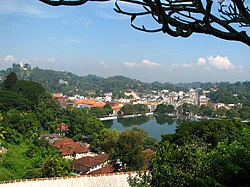キャンディ
Appearance
Japanese
[edit]Pronunciation
[edit]Etymology 1
[edit]
Borrowing from English candy.[1][2][3]
Although many dictionaries list キャンデー (kyandē) as the primary spelling,[1][2][3][4][5] the キャンディ (kyandi) spelling actually appears to be much more common in general usage.
Alternative forms
[edit]Noun
[edit]Derived terms
[edit]- キャンディ棒 (kyandibō, “candy cane”)
See also
[edit]- 飴 (ame): sweets (usually referring to traditional Japanese confections)
- 菓子 (kashi): sweets (usually referring to baked goods)
Etymology 2
[edit]
Ultimately from Tamil கண்டி (kaṇṭi), apparently borrowed via English Kandy.[2][3]
Proper noun
[edit]References
[edit]- ↑ 1.0 1.1 Shōgaku Tosho (1988) 国語大辞典(新装版) [Unabridged Dictionary of Japanese (Revised Edition)] (in Japanese), Tōkyō: Shogakukan, →ISBN
- ↑ 2.0 2.1 2.2 Matsumura, Akira, editor (2006), 大辞林 [Daijirin] (in Japanese), Third edition, Tokyo: Sanseidō, →ISBN
- ↑ 3.0 3.1 3.2 Matsumura, Akira (1995) 大辞泉 [Daijisen] (in Japanese), First edition, Tokyo: Shogakukan, →ISBN
- ^ Kindaichi, Kyōsuke et al., editors (1997), 新明解国語辞典 [Shin Meikai Kokugo Jiten] (in Japanese), Fifth edition, Tokyo: Sanseidō, →ISBN
- ^ NHK Broadcasting Culture Research Institute, editor (1998), NHK日本語発音アクセント辞典 [NHK Japanese Pronunciation Accent Dictionary] (in Japanese), Tokyo: NHK Publishing, Inc., →ISBN

